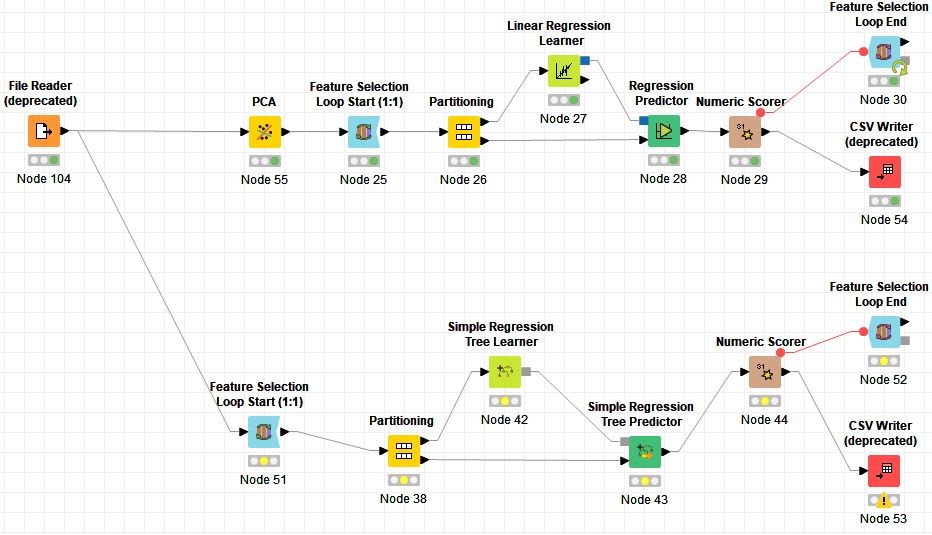FTIR fingerprint — testing a new representation of the binary fingerprint based on FTIR spectra in the prediction of physicochemical properties
DOI:
https://doi.org/10.55225/sti.492Keywords:
binary fingerprint, FTIR spectroscopy, Savitzky-Golay filter, FEDS, prediction models, physicochemical propertiesAbstract
The paper deals with the development of a new method for the generation of binary fingerprints based on the Savitzky-Golay (SG) algorithm and first-order derivatives of FTIR spectra, which are then used to create prediction models for selected the physicochemical properties of chemical compounds. Models based on the FEDS (Functionally-Enhanced Derivative Spectroscopy) transformation and raw spectra were used as a reference to determine whether the use of the SG filter and first-order derivatives was worth to further develop. The FTIR spectra of 103 compounds with theoretically determined values of logP, logD and logS were studied. The Tanimoto coefficient and correlation coefficient were used to compare the fingerprints obtained, while the root mean square error (RMSE) was used to assess the quality of the prediction models. Based on the results, it was found that the use of the SG filter and derivatives had a positive effect on the quality of the prediction models for logP and logS, and a negative effect on the quality of the models for logD, compared to the models based on original spectra and FEDS transformation.
Downloads
References
Terstappen GC, Reggiani A. In silico research in drug discovery. Trends in Pharmacological Sciences. 2001;22(1):23–26. HTTPS://DOI.ORG/10.1016/S0165-6147(00)01584-4. DOI: https://doi.org/10.1016/S0165-6147(00)01584-4 Google Scholar
Willett P, Barnard JM, Downs GM. Chemical similarity searching. Journal of Chemical Information and Computer Sciences. 1998;38(6):983–996, 1998, https://doi.org/10.1021/ci9800211. DOI: https://doi.org/10.1021/ci9800211 Google Scholar
Bajorath J. Selected concepts and investigations in compound classification, molecular descriptor analysis, and virtual screening. Journal of Chemical Information and Computer Sciences. 2001;41(2):233–245. https://doi.org/10.1021/ci0001482. DOI: https://doi.org/10.1021/ci0001482 Google Scholar
Wigh DS, Goodman JM, Lapkin AA. A review of molecular representation in the age of machine learning. WIREs: Computional Molecular Science. 2022;12(5):1–19. https://doi.org/10.1002/wcms.1603. DOI: https://doi.org/10.1002/wcms.1603 Google Scholar
Zagidullin B, Wang Z, Guan Y, Pitkänen E, Tang J. Comparative analysis of molecular fingerprints in prediction of drug combination effects. Briefings in Bioinformatics. 2021;22(6):1–15. https://doi.org/10.1093/bib/bbab291. DOI: https://doi.org/10.1093/bib/bbab291 Google Scholar
Ball DW. Field Guide to Spectroscopy [Internet]. Bellingham: SPIE Press; 2006. [cited 2022 June 21]. Available form: https://spie.org/Publications/Book/682726. DOI: https://doi.org/10.1117/3.682726 Google Scholar
Luo J, Ying K, Bai J. Savitzky-Golay smoothing and differentiation filter for even number data. Signal Processing. 2005;85(7):1429–1434. https://doi.org/10.1016/j.sigpro.2005.02.002. DOI: https://doi.org/10.1016/j.sigpro.2005.02.002 Google Scholar
Savitzky A, Golay MJE. Smoothing and differentiation of data by simplified least squares procedures. Analytical Chemistry. 1964;36(8):1639–1643. https://doi.org/10.1021/ac60214a048. DOI: https://doi.org/10.1021/ac60214a047 Google Scholar
Riordon ANJ, Zubritsky E. Top 10 articles. Analytical Chemistry. [Internet] 2000 [cited 2022 June 21]. Available form: http://pubs.acs.org/ac. DOI: https://doi.org/10.1021/ac002801q Google Scholar
Schafer RW. What is a Savitzky-Golay filter? [Lecture notes]. IEEE Signal Processing Magazine. 2011;28(4):111–117. https://doi.org/10.1109/MSP.2011.941097. DOI: https://doi.org/10.1109/MSP.2011.941097 Google Scholar
Cygański A. Metody spektroskopowe w chemii analitycznej. Warszawa: Wydawnictwo WNT; 2017. Google Scholar
de Aragão BJG, Messaddeq Y. Peak separation by derivative spectroscopy applied to FTIR analysis of hydrolized silica. Journal of the Brazilian Chemical Society. 2008;19(8):1582–1594. https://doi.org/10.1590/S0103-50532008000800019. DOI: https://doi.org/10.1590/S0103-50532008000800019 Google Scholar
Palencia M. Functional transformation of Fourier-transform mid-infrared spectrum for improving spectral specificity by simple algorithm based on wavelet-like functions. Journal of Advanced Research. 2018;14:53–62. Htttps://doi.org/10.1016/J.JARE.2018.05.009. DOI: https://doi.org/10.1016/j.jare.2018.05.009 Google Scholar
Rieppo L, Saarakkala S, Närhi T, Helminen HJ, Jurvelin JS, Rieppo J. Application of second derivative spectroscopy for increasing molecular specificity of fourier transform infrared spectroscopic imaging of articular cartilage. Osteoarthritis and Cartilage. 2012;20(5):451–459. https://doi.org/10.1016/J.JOCA.2012.01.010. DOI: https://doi.org/10.1016/j.joca.2012.01.010 Google Scholar
Yukihiro O, Slobodan Š, Jiang JH. How can we unravel complicated near infrared spectra? Recent progress in spectral analysis methods for resolution enhancement and band assignments in the near infrared region. Journal of Near Infrared Spectroscopy. 2001;9(2). https://doi.org/10.1255/jnirs.2. DOI: https://doi.org/10.1255/jnirs.295 Google Scholar
Otálora A, Palencia M. Application of functionally-enhanced derivative spectroscopy (FEDS) to the problem of the overlap of spectral signals in binary mixtures: Triethylamine-acetone. Journal of Science with Technological Applications. 2019;6:96–107. https://doi.org/10.34294/J.JSTA.19.6.44. DOI: https://doi.org/10.34294/j.jsta.19.6.44 Google Scholar
Golonka D. Development of a new chemical compound representation based on FTIR spectrum for prediction of physicochemical properties of potential therapeutic substances [master thesis]. Kraków: Jagiellonian University; 2021. Google Scholar
Kurczab R, Golonka D. A new approach to encoding the chemical structure based on the FTIR spectra of compound. In: Xth Conversatory on Medicinal Chemistry in Lublin; 2021. https://doi.org/10.13140/RG.2.2.18264.01284. Google Scholar
Gorzynski Smith J. Chapter 13: Mass spectrometry and infrared spectroscopy. In: Organic Chemistry. 3rd ed. New York: McGraw-Hill; 2011. p. 463–488. Google Scholar
Kennepohl D, Farmer S, Reusch W. 11.5: Infrared Spectra of Some Common Functional Groups. In: LibreTexts: Chemistry [Internet]. [cited 2023, March 11]. Available from: https://chem.libretexts.org/Bookshelves/Organic_Chemistry/Map%3A_Organic_Chemistry_(Wade)_Complete_and_Semesters_I_and_II/Map%3A_Organic_Chemistry_(Wade)/11%3A_Infrared_Spectroscopy_and_Mass_Spectrometry/11.05%3A_Infrared_Spectra_of_Some_Common_Functional_Groups. Google Scholar

Downloads
Published
How to Cite
Issue
Section
License
Copyright (c) 2023 Kacper Tomaszewski, Rafał Kurczab

This work is licensed under a Creative Commons Attribution-ShareAlike 4.0 International License.



